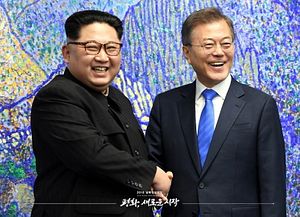South Korean President Moon Jae-in said on Monday that the United States, China, and North Korea have agreed “in principle” to declare an end to the 1950-53 Korean War.
Moon was speaking at a joint press conference with Australia Prime Minister Scott Morrison. During his visit to Canberra, Moon asked Australia to support his peace process for the Korean Peninsula, while reaffirming their common interests for advancing their alliance.
Moon and Morrison agreed to strengthen the countries’ strategic partnership on security and defense amid the rising tensions between the two superpowers – the United States and China – and North Korea’s growing missile and nuclear capabilities. As a first step showing their upgraded partnership and alliance, Australia signed a contract to buy 30 units of South Korea’s K-9 Thunder self-propelled howitzer.
Despite the fruitful meeting and contract, the biggest headline from the meeting came after Moon’s remark on the end-of-war declaration, his final attempt to restart deadlocked North Korea-U.S. nuclear talks and inter-Korean dialogues. However, Moon’s latest comment actually is evidence that there has been no substantial progress with his final attempt.
The United States and China have already offered their theoretical support for the end-of-war declaration proposed by Moon in his speech at the United Nations in September. Kim Yo Jong, the powerful sister of the North Korean leader Kim Jong Un, also once said it is an interesting proposal but questioned the timing of the declaration.
As North Korea has already made clear that it will not come back to the negotiating table unless the United States and South Korea remove their “hostile policy,” Pyongyang has not shown any interest in renewing dialogue with Moon to discuss the end-of-war declaration. The two countries had previously agreed to discuss the declaration of the end of the Korean War in the inter-Korean summit meetings in 2007 and 2018. However, the failed 2019 North Korea-U.S. summit in Hanoi dashed Moon’s hope to achieve significant process with his peace process before the end of his tenure. Pyongyang deemed then-U.S. President Donald Trump’s decision to walk out of the door with no deal as a profound humiliation to their supreme leader, who spent about 66 hours on a train to attend the summit meeting in Vietnam.
With that in mind, what does an agreement “in principle” on the formal end of Korean War mean?
Support “in principle” is explicitly different from support in practice. The Biden administration has signaled that it has reservations about Moon’s peace process being both premature and insufficient. Many U.S. analysts see the peace process, including the end-of-war declaration, as Moon’s attempt to carve out a historical legacy on the North Korea issue.
The Moon administration has consistently emphasized that Washington and Seoul are on the same page but there are plenty of signs otherwise. Earlier this month, 35 U.S. Republican representatives asked the Biden administration not to sign such a declaration before denuclearizing North Korea. Before that, White House National Security Advisor Jake Sullivan had said that Washington and Seoul may have “different perspectives on the precise sequence or timing or conditions for different steps” when asked about U.S. support for the end-of-war declaration.
As the South Korean presidential election is set for March 9, the U.S. is likely to wait and see who will run the Blue House next, as the two major presidential candidates from the ruling Democratic Party and conservative People Power Party have considerably different overtures and policies on the North Korea issue.
China has different calculations behind its stance on the end-of-war declaration. As the largest trading partner and the most important ally of North Korea, China would like to keep the North as a buffer zone on the Korean Peninsula to check the U.S. leverage in the region. China does not, however, want North Korea to beef up its nuclear and missile capabilities, as an arms build-up could engender more U.S. missile deployments in South Korea – Beijing vociferously opposed Seoul’s decision to deploy the U.S. Terminal High Altitude Area Defense (THAAD) system in 2016. At the same time, China also does not wish North Korea to actively engage in peace talks with the United States as it could leave China isolated in the East Asia region. In this context, China’s preferred scenario is maintaining the status quo: offering rhetorical support for Moon’s peace process but not taking concrete steps toward the end-of-war declaration.
Clearly, the two superpowers are using Moon’s proposal for their own interests. Meanwhile, the clock is ticking on Seoul’s side, with Moon due to leave office in May 2022. In a bid to convince both Washington and Beijing to cooperate on the North Korea issue, Moon has been taking a strategic approach by standing in the middle of the many conflicting issues dividing China and the United States. However, in the end, Pyongyang is the one delaying Seoul’s peace process by demanding the withdrawal of U.S. troops in South Korea and a halt to the joint U.S.-South Korea military drills before re-engaging.

































